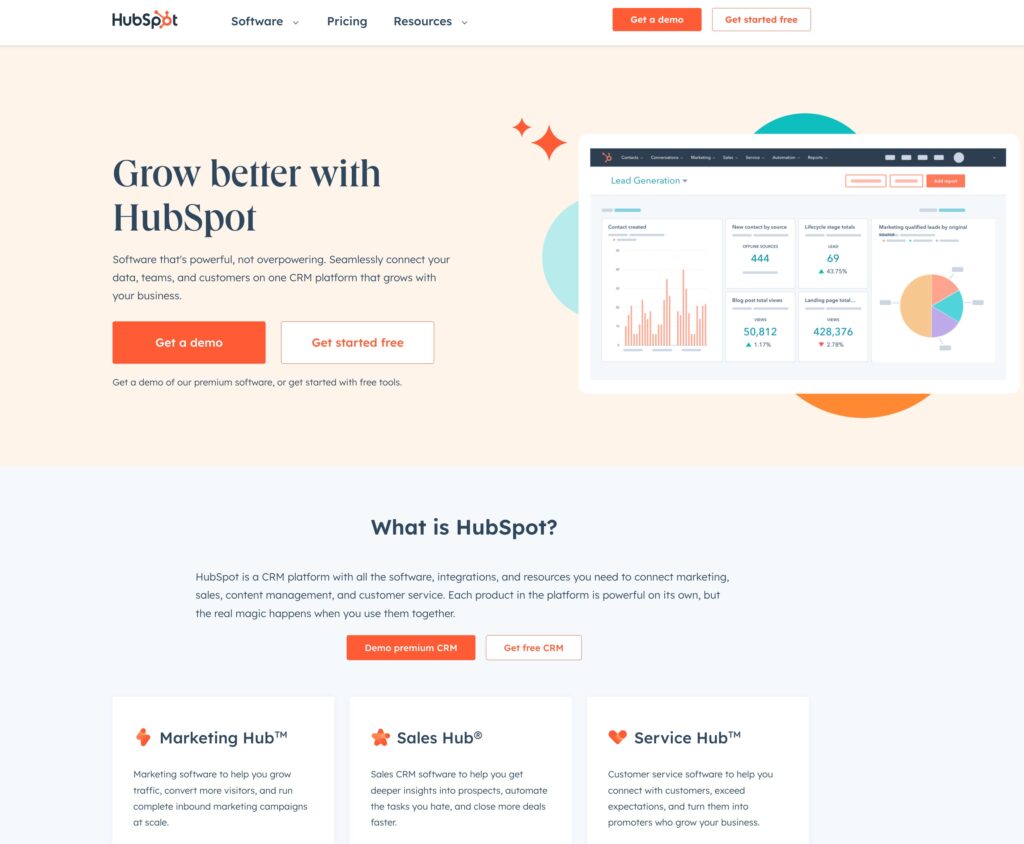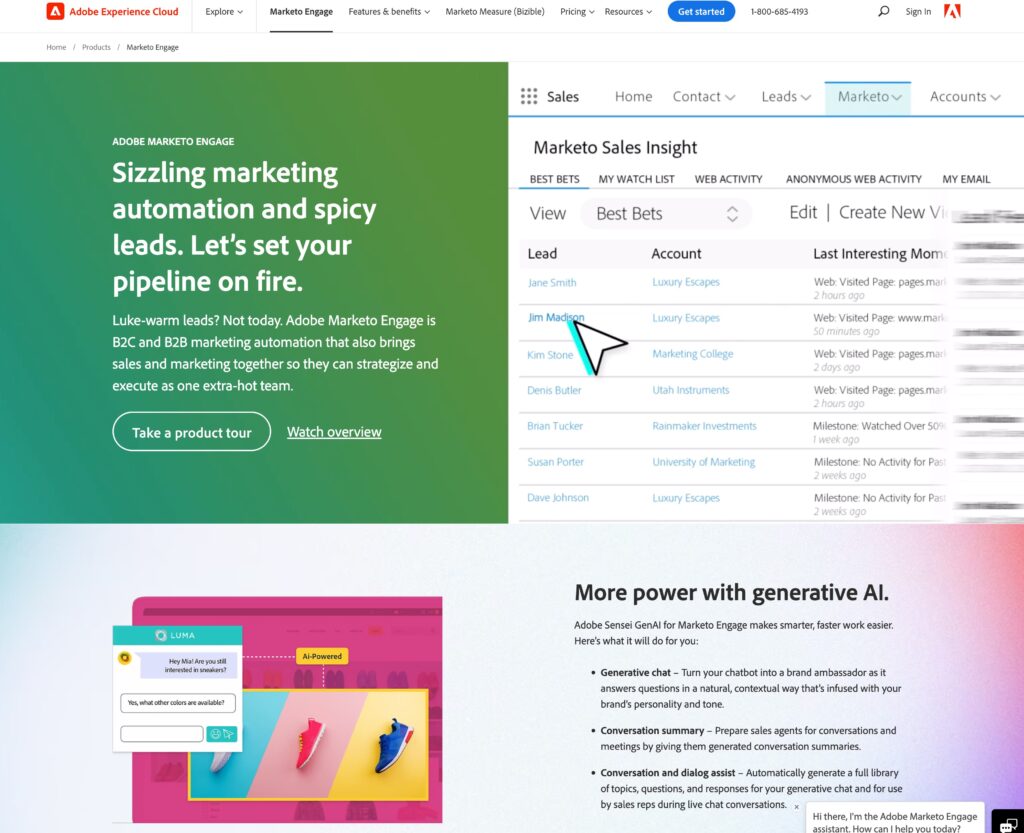Marketers today have more tools than ever to optimize, improve, and streamline their marketing. When it comes to marketing automation platforms, there are many options to choose from. Three of the most popular platforms are HubSpot, Marketo, and Pardot. Each platform has unique strengths and weaknesses, and it’s crucial to carefully consider which is the best fit for your organization, given its goals and team.
To help you make an informed decision, here’s a breakdown of the key features and benefits of each platform:
| Feature | HubSpot | Marketo | Pardot |
| Pricing Model | Subscription-based, with a free CRM and various pricing tiers based on the features and services needed | Subscription-based, with pricing tiers based on the number of contacts in your database and the features needed | Subscription-based, with pricing tiers based on the number of contacts in your database and the features needed |
| Target Audience | Small to mid-sized businesses, with a focus on inbound marketing | Enterprise-level businesses, with a focus on account-based marketing | Mid-sized businesses, with a focus on lead generation and nurturing |
| Key Features | All-in-one platform for marketing, sales, and customer service, with robust analytics and reporting capabilities | Advanced lead management capabilities, sophisticated email marketing tools, and integration with Salesforce | Lead scoring and grading capabilities, advanced email marketing and analytics tools, and integration with Salesforce |
| Pros | Easy to use, with a focus on inbound marketing and lead generation, and a wide range of integrations with other tools and platforms | Advanced lead management and email marketing capabilities, with a strong focus on account-based marketing and enterprise-level businesses | Advanced email marketing and analytics tools, with a focus on lead generation and nurturing, and strong integration with Salesforce |
| Cons | Limited support for account-based marketing, and may be too basic for some enterprise-level businesses | Can be complex and difficult to use, and may be too expensive for smaller businesses | Limited customer support, and may not be suitable for businesses with more complex marketing needs |
As you can see, each platform has its own unique strengths and weaknesses, and it’s essential to carefully evaluate your organization’s needs and goals to determine which platform is the best fit. By considering factors like pricing, target audience, key features, and pros and cons, you can make an informed decision and choose the marketing automation platform to help your business achieve its marketing and sales goals.
HubSpot

HubSpot is an all-in-one marketing automation platform that offers a range of tools and features to help businesses attract, engage, and delight customers. Here’s a breakdown of some of the key features of HubSpot:
All-in-One Platform
One of the most significant benefits of HubSpot is that it’s an all-in-one platform, which means it includes a range of tools and features for marketing, sales, and customer service. Some of the key features of the platform include:
- Marketing Hub: Includes tools for creating and optimizing website content, managing social media accounts, running email campaigns, and tracking analytics and reporting.
- Sales Hub: Includes tools for managing leads and contacts, tracking deals and sales activities, and automating sales tasks.
- Service Hub: Includes tools for managing customer support tickets, creating knowledge base articles, and collecting customer feedback.
Using HubSpot’s all-in-one platform, businesses can streamline their marketing and sales efforts and gain deeper insights into their customers’ behavior and preferences.
Robust Analytics and Reporting
Another key feature of HubSpot is its robust analytics and reporting capabilities. The platform includes a range of tools and dashboards that allow businesses to track their marketing and sales activities and measure the success of their campaigns. Some of the key metrics that HubSpot tracks include:
- Website traffic: Number of visits, sessions, and pageviews.
- Email marketing: Open rates, click-through rates, and conversion rates.
- Social media: Reach, engagement, and follower growth.
- Sales: Number of deals closed, revenue generated, and sales pipeline performance.
Using HubSpot’s analytics and reporting tools, businesses can gain valuable insights into their marketing and sales activities and make data-driven decisions to improve performance.
Pros and Cons of Using HubSpot
Like any marketing automation platform, HubSpot has its pros and cons. Here are some of the key advantages and disadvantages of using HubSpot:
Pros
- Ease of use: HubSpot is known for being easy to use and user-friendly, with a drag-and-drop interface and various templates and tools.
- Inbound marketing focus: HubSpot is designed with inbound marketing in mind, which means it includes tools and features for attracting and engaging leads through content marketing and other inbound strategies.
- Integrations: HubSpot integrates with many other tools and platforms, including Salesforce, Zapier, and Shopify.
Cons
- Limited support for account-based marketing: HubSpot’s focus on inbound marketing may not be the best fit for businesses with a strong focus on account-based marketing.
- It may be too basic for some enterprise-level businesses: While HubSpot is a powerful tool, it may not have all the features and capabilities that larger, more complex enterprises require.
- Pricing: HubSpot’s pricing can be relatively expensive compared to other marketing automation platforms, especially for businesses that need access to all the platform’s features and tools.
Overall, HubSpot is a powerful marketing automation platform with a range of tools and features for businesses of all sizes. HubSpot makes it easy to create marketing that drives revenue by unifying sales and marketing in an all-in-one platform with robust analytics, reporting capabilities, and an easy-to-use interface.
Marketo

Marketo is a marketing automation platform focusing on lead management and account-based marketing. Here’s a breakdown of some of the key features of Marketo:
Advanced Lead Management
One of the biggest benefits of Marketo is its advanced lead management capabilities. The platform includes a range of tools and features for managing leads and contacts, including:
- Lead scoring and grading: Ability to prioritize leads based on their level of engagement and interest.
- Lead nurturing: Allows businesses to send targeted and personalized messages to leads based on their behavior and interests.
- Account-based marketing: Options to target specific accounts and decision-makers with personalized messaging and content.
With Marketo’s advanced lead management capabilities, businesses can improve their lead generation and conversion efforts and better understand their customers’ behavior and preferences.
Sophisticated Email Marketing
Another key feature of Marketo is its sophisticated email marketing tools. The platform includes a range of features for creating and sending targeted and personalized email campaigns, having:
- Email design and templates: Gives businesses the ability to create visually appealing and responsive emails without needing design or coding skills.
- Personalization and segmentation: Capability to send personalized messages to different email list segments based on behavior, interests, and other criteria.
- A/B testing and optimization: Test and optimize their email campaigns to improve open, click-through, and conversion rates.
Marketo’s options for sophisticated email marketing tools let businesses create more engaging and effective email campaigns and improve their overall marketing and sales performance.
Pros and Cons of Using Marketo
Like any marketing automation platform, Marketo has its own set of pros and cons. Here are some of the key advantages and disadvantages of using Marketo:
Pros
- Advanced lead management: Marketo’s advanced lead management capabilities helps prioritize and nurture leads more effectively and achieve higher conversion rates.
- Sophisticated email marketing: Marketo’s email marketing tools enable businesses to create more targeted and personalized campaigns and improve their email engagement and conversion rates.
- Integration with Salesforce: Marketo integrates seamlessly with Salesforce (being that they’re the parent company), allowing businesses to create a powerful marketing and sales stack.
- Generative AI Integration: Implementation of AI tools into Marketo can help boost productivity.
Cons
- Complexity: Marketo can be a complex and challenging platform to use, especially for businesses that are new to marketing automation.
- Expensive pricing: Marketo’s pricing can be relatively expensive compared to other marketing automation platforms, especially for businesses that need access to all the platform’s features and tools.
- Limited support for small businesses: Marketo is primarily designed for enterprise-level businesses, which means that smaller businesses may not find all the necessary features and tools.
Overall, Marketo is a powerful marketing automation platform with a range of tools and features for lead management, account-based marketing, and email marketing. By using Marketo’s advanced lead management capabilities, sophisticated email marketing tools, and seamless integration with Salesforce, businesses can improve their marketing and sales efforts and achieve their business goals.
Pardot

Pardot is a marketing automation platform that focuses on lead generation and nurturing. Here’s a breakdown of some of the key features of Pardot:
Lead Scoring and Grading
One of the biggest benefits of Pardot is its lead scoring and grading capabilities. The platform allows businesses to assign scores and grades to leads based on their behavior, interests, and demographics. This allows businesses to prioritize leads and focus their efforts on those most likely to convert. Some of the key features of Pardot’s lead scoring and grading capabilities include:
- Customizable scoring models: Makes it possible for businesses to create custom scoring models based on their unique criteria and priorities.
- Real-time lead scoring: Option businesses to see the score and grade of each lead in real-time, and adjust their marketing and sales efforts accordingly.
- Automated lead nurturing: Allows businesses to automatically send targeted and personalized messages to leads based on their behavior and interests.
With Pardot’s lead scoring and grading capabilities, businesses can improve their lead generation and conversion efforts and better understand their customers’ behavior and preferences.
Advanced Email Marketing and Analytics
Another key feature of Pardot is its advanced email marketing and analytics tools. The platform includes a range of features for creating and sending targeted and personalized email campaigns, having:
- Email design and templates: Ability to create visually appealing and responsive emails without needing design or coding skills.
- Dynamic content: Send personalized messages to different email list segments based on behavior, interests, and other criteria.
- Advanced analytics: Track and analyze the performance of their email campaigns and make data-driven decisions to improve their marketing and sales performance.
Businesses can use Pardot’s advanced email marketing and analytics tools to create more engaging and effective email campaigns and gain deeper insights into their customers’ behavior and preferences.
Pros and Cons of Using Pardot
Like any marketing automation platform, Pardot has its own set of pros and cons. Here are some of the key advantages and disadvantages of using Pardot:
Pros
- Lead scoring and grading: Pardot’s lead scoring and grading capabilities with option for businesses to prioritize and nurture leads more effectively and achieve higher conversion rates.
- Advanced email marketing and analytics: Pardot’s email marketing and analytics tools allow businesses to create more targeted and personalized campaigns and gain deeper insights into their customers’ behavior and preferences.
- Integration with Salesforce: Pardot integrates seamlessly with Salesforce, allowing businesses to create a powerful marketing and sales stack.
Cons
- Limited customer support: Pardot’s customer support is known to be limited, which can be frustrating for businesses that need assistance.
- Pricing: Pardot’s pricing can be relatively expensive compared to other marketing automation platforms, especially for businesses that need access to all the platform’s features and tools.
- Focus on lead generation and nurturing: Pardot’s focus on lead generation and nurturing means that there may be better fits for businesses with a strong focus on account-based marketing.
Overall, Pardot is a powerful marketing automation platform with a range of tools and features for lead generation, lead scoring, and email marketing. By using Pardot’s advanced lead scoring and grading capabilities, sophisticated email marketing and analytics tools, and seamless integration with Salesforce, businesses can improve their marketing and sales efforts and achieve their business goals.
Decision
HubSpot may be the best fit if your organization is a small to mid-sized business focusing on inbound marketing and lead generation. With its all-in-one platform, easy-to-use interface, and robust analytics and reporting capabilities, HubSpot is a powerful tool for improving your marketing and sales efforts.
If your organization is an enterprise-level business with a strong focus on account-based marketing, Marketo may be the best fit. With its advanced lead management capabilities, sophisticated email marketing tools, and seamless integration with Salesforce, Marketo is a powerful tool for improving your marketing and sales efforts.
If your organization is a mid-sized business focusing on lead generation and nurturing, Pardot may be the best fit. With its lead scoring and grading capabilities, advanced email marketing and analytics tools, and seamless integration with Salesforce, Pardot is a powerful tool for improving your marketing and sales efforts.
Overall (and we’re a bit biased as Hubspot-certified partners!), Hubspot is the most versatile of the 3 and can do the job of Marketo and Pardot without missing a beat. And contact us if you need help setting up Hubspot.
Ultimately, the key to choosing the right marketing automation platform is to carefully evaluate your organization’s needs and goals and select the platform that best aligns with your business objectives. By considering factors like pricing, target audience, key features, and pros and cons, you can make an informed decision and choose the marketing automation platform to help your business achieve its marketing and sales goals.



